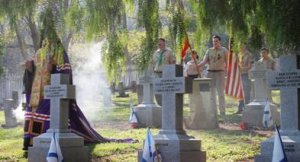
Zoya Gradov
.
It is noon on a warm November day. The autumn air is saturated with the smell of eucalyptus, blending with the aroma of the censer’s smoke, the intricate coils of which turn into transparent streams that float out over the gravestones and crosses. People listen to the words of the prayers in absorbed silence, holding red carnations in their hands. Russian scouts stand all in a row, motionless.
Whose loved ones are being commemorated at the old Naval Cemetery on this day? For whom have these Russian diplomats, American servicemen, parents and children, members of the old emigration, and newcomers gathered? They have not come to pray for their own loved ones but to commemorate the Russian sailors who, long ago, had found eternal rest on California soil at the U.S. Naval Cemetery peculiarly named "Mare Island.”
Their story begins in a distant past, when Russia and the United States of America—two great powers—were on friendly terms and nothing forebode that this accord would ever change. It was autumn of 1863. In early October, the Russian Pacific squadron, comprising five ships under the command of Rear Admiral A. A. Popov, entered San Francisco Bay. Nearly a month prior, a six-vessel squadron of the Baltic fleet had entered the port of New York. In this way, a section of the Russian Imperial fleet consisting of eleven warships, 3,000 sailors, and 260 guns were anchored just off the coast of the United States.
What was the reason for such an unprecedented visit? In 1863, the United States was in the midst of a Civil War between the North and South. England and France supported the South and were preparing for a blockade of the northern states. The political and military situation in Russia was not simple either. 1863 saw the beginning of the Polish uprising, also supported by the English and French governments. Russian ships were under orders to intercept the trade vessels of these countries should war erupt.
Although neither squadron was involved in military action undertaken by the northern states, the appearance of Russian ships in northern ports alone was enough to have an effect. Many American historians have expressed the belief that the Russians deployed their vessels at a critical moment—when the fall of the United States was nearly certain, as was the likelihood that French and British forces would take advantage of such a calamity. However, the sudden appearance of the Russian sailors assisted in American victory and prevented hostile intervention along with any subsequent dissolution of the federal government. Gideon Welles, the U.S. Secretary of the Navy, alluded to this fact in his diary with an entry that read, "God bless the Russians.”
Read more in the Diocesan Spiritual Spring Journal, Vol. 2 (#4), p. 55-59.



_jpg/250px-ElbeDay1945_(NARA_ww2-121).jpg)





